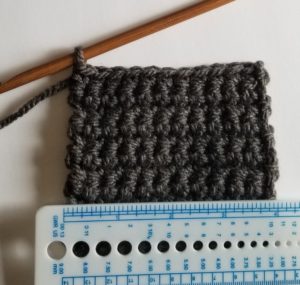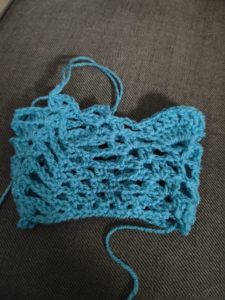What is a Crochet Gauge Swatch
Jump To:
It appears that you have never used a crochet gauge or are unfamiliar with the phrase “gauge” while you just started to learn how to crochet. Many crocheters grumble about swatching, claiming that it makes everything too complicated, much like that one time you did a project without them. Here we are to help you with everything you need to know about what is crochet gauge swatch.

Perhaps you heard about the advantages of swatching from other crocheters and chose to apply them in all of your projects for the same reason.
When it comes to swatching or making a swatch, crocheters appear to be divided into three groups:
- Those who are unfamiliar with the term “swatches.”
- Those who despise swatching and refuse to engage in it
- Those who recognize the value of swatches have made peace with them and used them in every endeavor.
What is a swatch
A swatch is a tiny sample of a larger project that is usually around 4″ × 4″ in size but can be greater based on the pattern design’s intricacy. It’s similar to the little cardboard models of real-size buildings architects create.
The stitch(es) in a sample gauge will typically repeat in the very same way/order as they would in a larger, finished product.

How to measure a crochet swatch
There are a few ways to measure out the crochet swatch.
- Of course, start with the swatch.
- It’s a good idea to make a crochet swatch that’s a little bigger than the design calls for. Standard gauge sizes are 4″x4″, but making it at least 5″x’5″ or 6″x6″ will make measuring and counting rows and stitches much more effortless.
- You may measure the gauge swatch with an ordinary school ruler once you have it. Even if you have a measuring tape, it isn’t the ideal option because it is flexible and can result in skewed counts.
- You can get a crochet gauge ruler if you want to be extra fancy.
- They usually come in a square or rectangular ruler with a 4″x4″ square opening within and are designed specifically to measure crochet gauge swatches.
Importance of the swatch
The second group considers it a waste of effort, yet making a swatch for a future project offers numerous advantages, especially one as huge as a blanket.
Here is why creating a swatch is essential:
- Swatches allow you to experiment with stitch order and overall stitch design on a smaller scale before committing to a larger project and wasting a lot of time.
- You can figure out how many stitches and rows you’ll need to reach the finished size you desire, the size hook or needle you’ll need, how much yarn you’ll need, and more by using the swatch.
- The gauge swatch allows you to anticipate accurate measurements for a future project without spending a lot of time manufacturing it.
Creating a gauge swatch while working on your design
- A swatch serves as a foundation for all the calculations you’ll need to get your crochet creation perfect if you’re working on your design.
- It can assist you in determining the number of rows and stitches required for the size and shape of the product you’re working on.
- It also gives you the numbers you need to figure out how big or little the project you’re working on can be.
- Swatches allow you to examine how your yarn would look with the stitches you’ve planned.
- Swatch can even help you figure out how much yarn you’ll need for the entire project before you begin.
Stitch gauge vs. Row gauge
The two measurements you’ll be working with when working with the gauge swatch are Stitch Gauge and Row Gauge.
- The number of stitches in a row of a swatch is referred to as a stitch gauge.
- Row Gauge refers to the number of rows in a single swatch row.
Those two gauges work in tandem, but they’re also separate.
Sometimes you’ll find that the sample’s width (stitch gauge) is correct, but the height is incorrect (that is, row gauge).
How to solve crochet gauge problems
When you are working on your own design
- You can begin using the appropriate hook size for the yarn weight you have.
- You can experiment with a little smaller or larger hook.
- The crochet fabric is tighter, more condensed, with smaller holes, and stiffer when using a smaller hook.
- With wider holes and more air getting through, the crochet fabric becomes looser, softer, and fluffier.
- You can obtain varied tensions in the crochet fabric by using smaller or larger hooks.
When you are working on someone else’s pattern
The initial step should always be to use the gauge that has been recommended. Crochet the swatch using the yarn weight/brand and hook size indicated by the pattern. If, on the other hand, your swatch comes out more petite, you’ll need to do some more work.
Here’s what’s going on and how you can alter the crochet gauge.
- It’s also conceivable that the yarn you’re using is lighter or thinner than what’s recommended.
- Consider using a different, thicker yarn to get the crochet gauge swatch to where it needs to be.
- If your swatch comes out larger, you’ll need to figure out the reason.
- You may crochet with loose tension. In that scenario, a smaller hook can help you get your stitches a little tighter and closer to the pattern’s stitches.
How do you read a crochet gauge swatch?
Simply, lay down your ruler/measuring tape and count the stitches across over a span of 4″ (or the length of the gauge in the pattern). Do the same vertically for the rows. You will now have your gauge.
How do I know my gauge?
The gauge measurement is the number printed next to the cutout circle. Gauge wheels usually provide the measurement in the gauge size along with the millimeters or inches.
What does gauge mean in yarn?
Gauge simply refers to the number of stitches a garment has per inch. The gauge depends on the following variables:
- Size of yarn.
- Size of needle.
- Stitch pattern.
Why is my crochet gauge so off?
If your gauge swatch is smaller than desired, or has more stitches and rows per inch than the designer’s sample, you’ll need to increase your hook size. Vice versa, decreasing hook size can fix a gauge swatch that is bigger than desired, or has fewer stitches and rows per inch than listed in the crochet pattern.
How do you read a gauge pattern?
To make a gauge swatch, using the yarn, needles and pattern stitch called for at the beginning of the pattern, cast on four times the specified number of stitches per inch. For example, if 5 stitches and 7 rows = 1″, cast on 20 stitches and work 28 rows in the pattern. The swatch should be 4″ square.